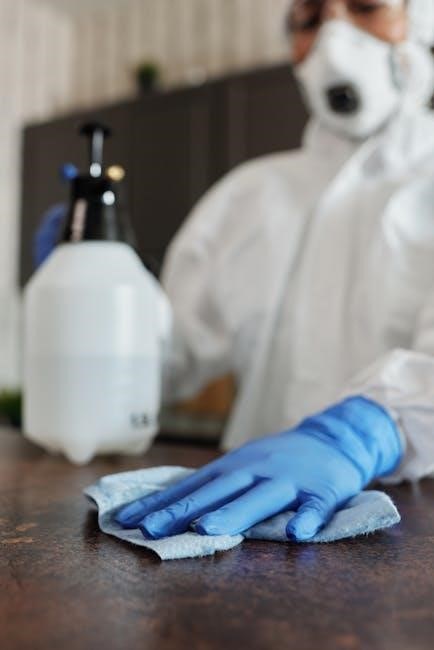Bacterial identification is crucial in microbiology, medicine, and research, enabling the classification of unknown bacteria into known species. This process involves morphological, biochemical, and molecular techniques to determine bacterial characteristics accurately.
1.1 Importance of Identifying Unknown Bacteria
Identifying unknown bacteria is essential for understanding their role in ecosystems, human health, and disease. Accurate identification enables proper medical treatment, as it helps determine the causative agent of infections. In environmental monitoring, it aids in assessing microbial diversity and potential bioremediation. In food safety, identifying bacteria prevents spoilage and poisoning. Additionally, it supports research by providing insights into bacterial physiology and genetics. Correct identification also informs public health strategies and epidemiological studies. Overall, bacterial identification is critical for advancing scientific knowledge, ensuring safety, and developing effective interventions across various fields.
1.2 Overview of Laboratory Techniques
Laboratory techniques for bacterial identification combine traditional and modern methods. Classical approaches include staining, microscopy, and culturing on selective media. Biochemical tests, such as sugar fermentation and enzyme assays, provide metabolic insights. Advanced techniques involve molecular biology, like DNA sequencing and MALDI-TOF mass spectrometry, for precise species identification. These methods are often used in combination to ensure accuracy. Laboratories also employ automated systems, such as API test strips, to streamline testing. Each technique offers unique advantages, and their integration ensures comprehensive bacterial characterization. Together, these methods form a robust framework for identifying unknown bacteria in clinical, environmental, and research settings.
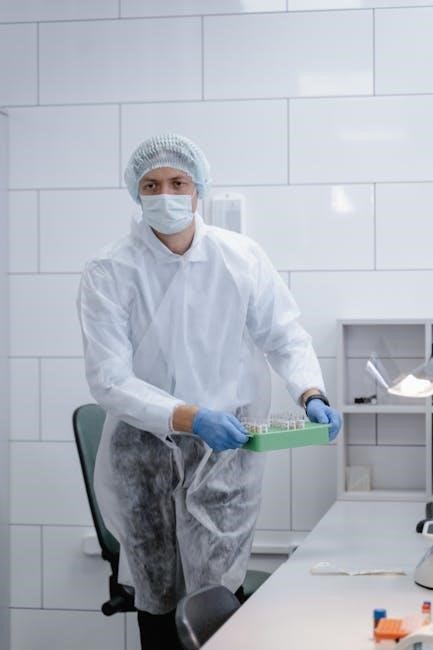
Materials and Methods
Essential materials include microscopes, incubators, agar plates, and biochemical reagents. Required equipment encompasses autoclaves, centrifuges, and spectrophotometers. Safety gear like gloves and lab coats is mandatory.
2.1 Required Laboratory Equipment
The identification of unknown bacteria requires specific laboratory equipment to ensure accurate and efficient analysis. Essential tools include a compound microscope for observing bacterial morphology, an autoclave for sterilizing materials, and an incubator to culture bacteria at optimal temperatures. Centrifuges are used to separate cellular components, while spectrophotometers measure bacterial growth and density. Additional equipment includes petri dishes for culturing, test tubes for broth cultures, and pipettes for precise liquid handling. These tools are critical for maintaining sterility, performing biochemical tests, and analyzing results effectively. Proper equipment ensures reliable outcomes in bacterial identification processes.
2.2 Chemicals and Reagents Needed
The identification of unknown bacteria requires a variety of chemicals and reagents to perform tests and maintain cultures. Essential chemicals include nutrient agar for bacterial growth, tryptic soy broth for liquid cultures, and sterile water for dilutions. Staining reagents like crystal violet, iodine, and safranin are used in Gram staining to differentiate bacterial cell walls. Enzymatic test reagents, such as hydrogen peroxide for catalase tests and tetramethyl-p-phenylenediamine for oxidase tests, are critical for biochemical analysis. Additionally, selective and differential media, like MacConkey and Mannitol Salt Agar, aid in isolating specific bacterial types. Ethanol and bleach are used for sterilization and surface disinfection.
2.3 Safety Precautions
When working with unknown bacteria, it is essential to follow strict safety protocols to minimize risks. Always wear personal protective equipment (PPE), including lab coats, gloves, and eye protection, to prevent skin and mucous membrane exposure. Handle bacterial cultures and chemicals in a biosafety cabinet or under a sterile hood when possible. Avoid ingestion, inhalation, or direct contact with potentially hazardous substances. Properly dispose of biohazardous waste in designated containers. Decontaminate surfaces and equipment regularly using ethanol or bleach solutions. In case of spills, contain them immediately and disinfect the area. Follow emergency procedures for accidents, such as needle sticks or chemical exposure.

Isolation and Cultivation of Bacteria
Isolation and cultivation involve obtaining pure bacterial cultures using techniques like streak plate and pour plate methods. These processes ensure bacterial purity and viability for further analysis.
3.1 Streak Plate Method
The streak plate method is a widely used technique for isolating pure bacterial cultures. It involves spreading a bacterial sample across an agar plate in a series of streaks or dilutions. The process begins by sterilizing an inoculation loop and transferring a small sample of bacteria to the plate. The bacteria are then streaked in a pattern designed to thin out the sample, ensuring individual cells can grow into isolated colonies. This method is effective for obtaining pure cultures, as each colony arises from a single bacterial cell. Proper sterilization between streaks prevents contamination, making it a reliable step in bacterial identification.

3.2 Pour Plate Method
The pour plate method is another technique used to isolate bacterial cultures, particularly for enumerating microorganisms. It involves preparing a molten agar solution, cooling it to around 45°C, and mixing it with a bacterial sample. The agar-sample mixture is then poured into sterile plates, where it solidifies, embedding the bacteria throughout the medium. This method ensures uniform distribution of microorganisms, making it ideal for quantitative analysis. Once solidified, the plates are incubated, allowing bacterial colonies to grow. While effective, this method is more labor-intensive and requires precise temperature control to prevent agar solidification before mixing with the sample.
3.4 Selective and Differential Media
Selective and differential media are specialized agar plates designed to isolate and identify specific bacterial species. Selective media inhibit the growth of unwanted bacteria while allowing target organisms to thrive, often through antibiotics or specific nutrients. Differential media, however, contain compounds that react with bacterial metabolites, producing visible changes that help distinguish species. For example, Mannitol Salt Agar selects for staphylococci, while MacConkey Agar differentiates lactose-fermenting bacteria. These media are crucial in bacterial identification, enabling researchers to narrow down potential species based on growth patterns and biochemical reactions. Their combined use streamlines the identification process, making them indispensable tools in microbiology labs.
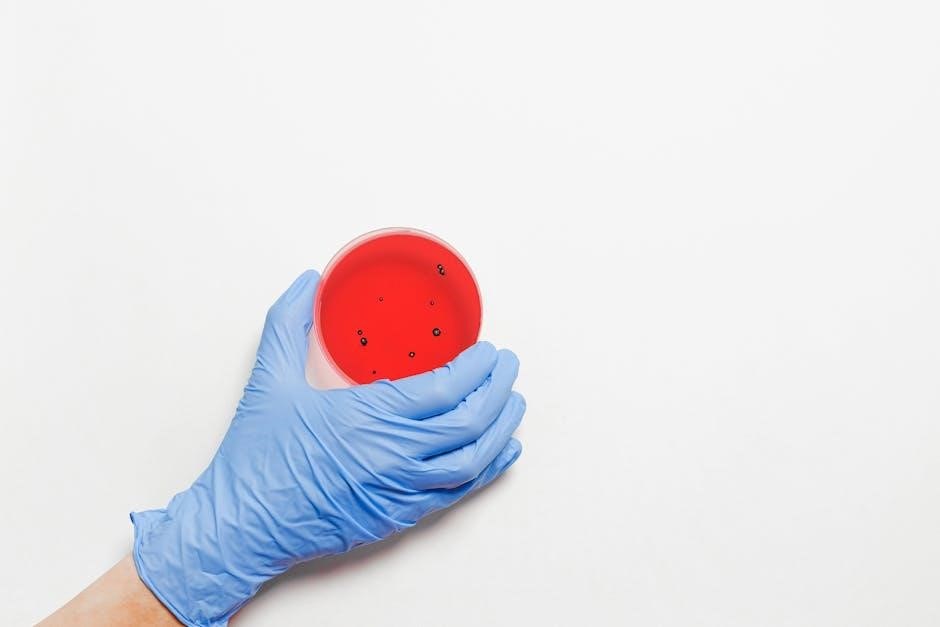
Morphological and Biochemical Tests
These morphological and biochemical tests are essential for identifying bacteria by examining their physical characteristics and metabolic processes, aiding in accurate classification and identification.
4.1 Gram Staining
Gram staining is a widely used technique in bacterial identification developed by Hans Christian Gram. It involves applying a series of dyes, including crystal violet, iodine, and safranin, to a bacterial smear on a slide. This method differentiates bacteria into two main groups: Gram-positive, which retain the purple dye, and Gram-negative, which appear pink or red due to the decolorization step. The process is quick and provides critical information about the bacterial cell wall structure, aiding in the preliminary identification and classification of unknown bacteria. Accurate Gram staining is essential for guiding further biochemical and molecular tests.
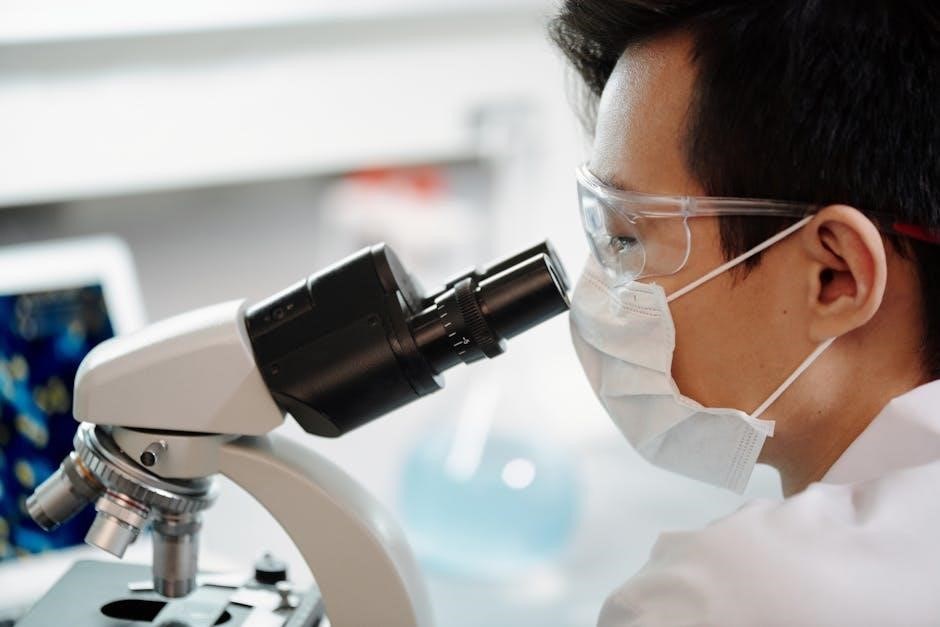
4.2 Cell Shape and Arrangement
Observing bacterial cell shape and arrangement under a microscope provides valuable information for identification. Common shapes include cocci (spherical), bacilli (rod-shaped), and spirilla (spiral). Arrangements like chains, clusters, or pairs can indicate specific growth patterns. For example, cocci may form clusters (Staphylococcus) or chains (Streptococcus), while bacilli can appear singly or in pairs (diplobacilli). These morphological features, combined with Gram staining results, help narrow down potential species. Accurate documentation of cell shape and arrangement is essential for creating a detailed lab report and guiding further biochemical tests. This step is fundamental in the systematic identification of unknown bacteria, enhancing diagnostic accuracy and research reliability.
4.3 Catalase and Oxidase Tests
The catalase test identifies bacteria producing the enzyme catalase, which breaks down hydrogen peroxide into water and oxygen. A positive result is indicated by bubble formation. The oxidase test detects the enzyme cytochrome c oxidase, involved in bacterial respiration. A blue color change confirms positivity. These tests are critical for differentiating bacterial species, such as distinguishing catalase-positive Staphylococcus from catalase-negative Streptococcus. Similarly, oxidase-positive bacteria like Neisseria and Pseudomonas can be identified. Both tests provide essential biochemical data, aiding in accurate bacterial identification when combined with other morphological and molecular analyses. They are simple yet effective tools in microbiological diagnostics and research, enhancing the reliability of lab findings.
4.4 Sugar Fermentation Tests
Sugar fermentation tests determine how bacteria metabolize specific sugars, aiding in identification. These tests are phenotypic, revealing metabolic capabilities. Common sugars tested include glucose, lactose, and sucrose. Bacteria are inoculated into media containing the sugar, and their ability to ferment it is observed. Acid production, indicated by a color change, or gas production, seen as bubbles, signifies fermentation. These tests help differentiate species based on metabolic byproducts. For example, Enterobacteriaceae members ferment glucose, while others may not. Results are recorded and compared to known profiles, aiding in accurate bacterial identification. This method is a cornerstone in microbiological diagnostics, providing critical biochemical data for classification.
Advanced Identification Techniques
Advanced methods like DNA sequencing and MALDI-TOF provide precise bacterial identification by analyzing genetic material and protein profiles, offering rapid and accurate results for unknown species.
5.1 API Test Strips
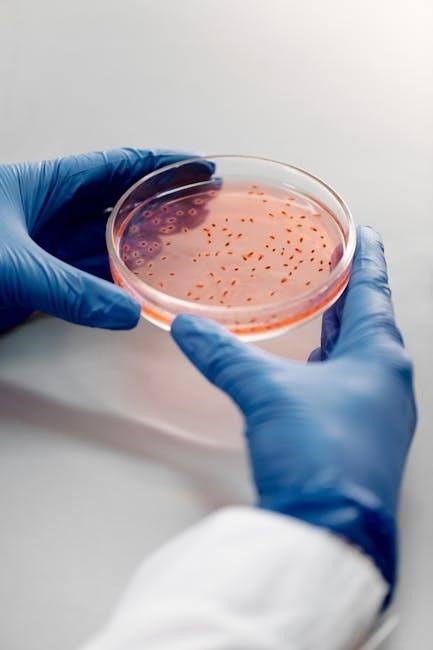
API test strips are a reliable method for bacterial identification, utilizing enzymatic reactions to determine metabolic capabilities. Each strip contains multiple substrates that change color when specific enzymes are present. This allows for the differentiation of bacterial species based on their biochemical profiles. API systems are widely used in clinical and research settings due to their simplicity and accuracy. By comparing the reaction patterns to a database, scientists can identify unknown bacteria efficiently. These strips are particularly useful for distinguishing between closely related species, making them a valuable tool in both routine and advanced microbiological analyses.
5.2 DNA Sequencing
DNA sequencing is a highly accurate method for identifying unknown bacteria by analyzing their genetic material. This technique involves extracting DNA from the bacterial sample, amplifying specific genes (e.g., the 16S rRNA gene), and sequencing the DNA. The obtained sequences are then compared to reference databases to determine the bacterial species. DNA sequencing provides precise identification, even for uncultivated or rare bacteria. While it requires specialized equipment and expertise, its high accuracy makes it a powerful tool in microbiological research and diagnostics. This method is particularly useful for identifying bacteria that cannot be cultured or distinguished through traditional biochemical tests.
5.3 MALDI-TOF Mass Spectrometry
MALDI-TOF (Matrix-Assisted Laser Desorption/Ionization Time-Of-Flight) mass spectrometry is a rapid and reliable technique for bacterial identification. It works by ionizing bacterial proteins and measuring their mass-to-charge ratio, creating a unique spectral fingerprint. These spectra are compared to reference databases for species identification. MALDI-TOF is highly accurate and efficient, requiring minimal sample preparation. It is particularly useful for identifying bacteria that are difficult to culture or distinguish using traditional methods. This technique has become a cornerstone in clinical microbiology labs due to its speed and reliability in processing multiple samples. It complements other methods like DNA sequencing for comprehensive bacterial identification.
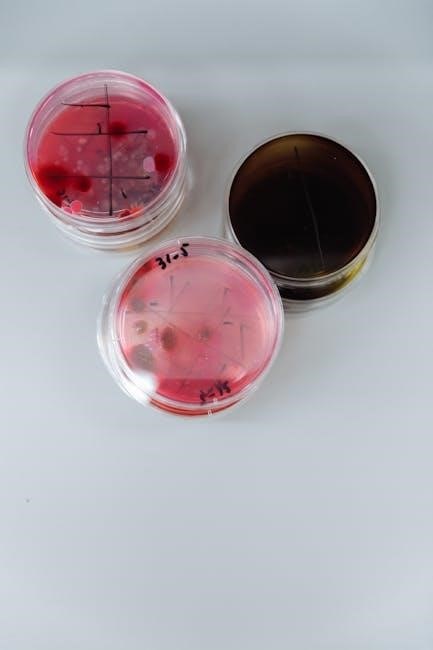
Data Analysis and Interpretation
Data analysis involves interpreting test results to identify bacterial species. This includes matching biochemical reactions, molecular data, and spectral patterns with reference databases for accurate classification.
6.1 Observations and Results
The observations and results section documents all experimental findings, including colony morphology, Gram staining outcomes, and biochemical test reactions. Physical characteristics such as colony color, shape, and texture are recorded. Staining techniques reveal cellular details, while enzymatic tests indicate metabolic capabilities. Sugar fermentation tests show acid production, and selective media isolate specific bacteria. Advanced methods like API strips or DNA sequencing provide precise identification. These observations are systematically recorded and compared to reference data for accurate species determination. This section serves as the foundation for interpreting bacterial characteristics and drawing conclusions about the unknown bacterium’s identity. All data is presented objectively, forming the basis for further analysis.
6.2 Matching with Known Bacterial Species
Matching the unknown bacterium with known species involves comparing experimental data with reference databases. Morphological traits, biochemical reactions, and molecular profiles are cross-referenced to identify similarities. Advanced techniques like API strips or DNA sequencing enhance accuracy. The process ensures precise classification, confirming the bacterium’s identity. This step is critical for medical diagnosis, environmental studies, and research applications. Accurate matching enables understanding of the bacterium’s characteristics, habitat, and potential impacts. The final identification is validated through comprehensive analysis, ensuring reliability and consistency with established microbial databases. This step concludes the identification process, providing a clear and definitive classification of the unknown bacterium.
The identification of unknown bacteria is essential for advancing microbiological research and medical applications. Accurate classification ensures proper understanding and utilization of bacterial species in various fields.
7.1 Final Identification of the Unknown Bacterium
The final identification of the unknown bacterium was determined through a combination of morphological, biochemical, and molecular analyses. Gram staining revealed the bacterium as Gram-positive, while biochemical tests confirmed its ability to ferment specific sugars. Advanced techniques such as DNA sequencing provided precise genetic identification, aligning the bacterium with a known species. This process underscores the importance of systematic laboratory methods in accurately classifying microbial organisms. The findings contribute to broader research in microbiology, offering insights into bacterial diversity and potential applications in medicine, agriculture, or environmental science. Accurate identification is crucial for understanding bacterial roles and implications in various ecosystems.
7.2 Implications of the Findings
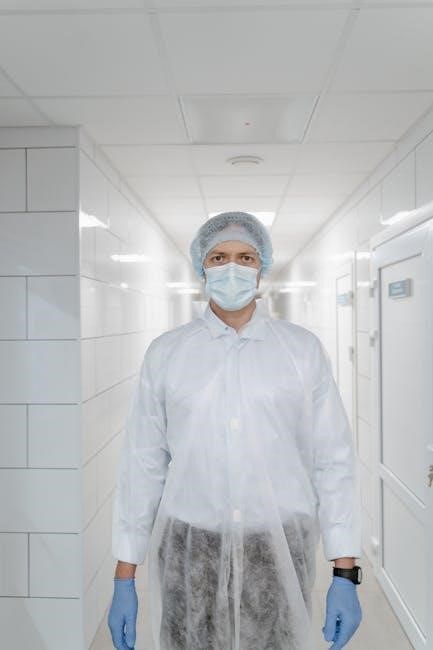
The identification of the unknown bacterium holds significant implications for medicine, environmental science, and research. Accurate classification enables targeted treatment strategies, reducing antibiotic misuse and improving patient outcomes. In environmental contexts, understanding bacterial roles can enhance bioremediation efforts and ecosystem balance. This discovery contributes to the broader scientific understanding of microbial diversity, aiding in the development of new technologies and treatments. Furthermore, it highlights the importance of continued research into bacterial identification methods, ensuring advancements in public health and ecological sustainability. The findings underscore the interconnectedness of microbiology with various fields, emphasizing its critical role in addressing global challenges.
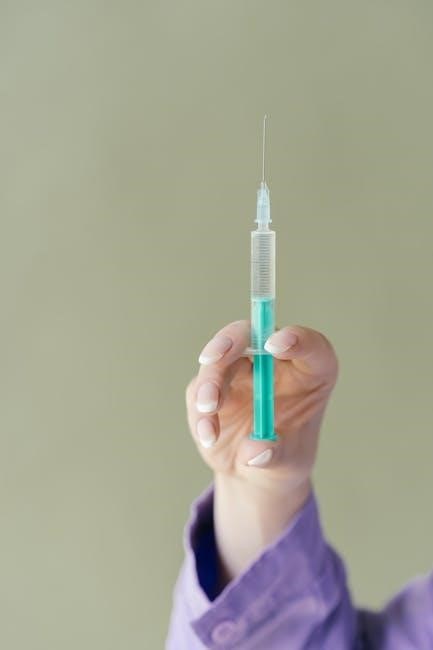
References and Further Reading
For further understanding of bacterial identification, key references include textbooks like “Bergey’s Manual of Systematic Bacteriology” and “Microbiology: An Evolving Science”. Online databases such as PubMed and ScienceDirect provide access to recent studies and methodologies. Additionally, laboratory manuals and guides, such as “Laboratory Methods in Microbiology”, offer practical insights into identification techniques. Websites like NCBI and MicrobeWiki are valuable resources for bacterial taxonomy and genomic data. These sources collectively provide a comprehensive foundation for understanding and applying bacterial identification methods in various scientific and clinical contexts.
